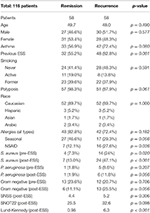Jul 01, 2016 · staphylococcus aureus has long been linked to chronic rhinosinusitis, particularly recalcitrant cases. in this article, alkis psaltis describes how newer techniques have shown higher rates of s. aureus infection than were previously thought, and explains how the bacteria are able to hide from both the immune system and our treatments. Book at sdand, jomtien beach. no reservation costs. great rates. For chronic sinusitis, antibiotics should cover s. aureus and be effective against the higher incidence of beta-lactamase producing organisms that are common in chronic disease. if the patient is not improving after 5 to 7 days, add metronidazole or clindamycin.
Sinusitis Statpearls Ncbi Bookshelf


Sinusitis wikipedia.
[full text] efficacy of silk fibroin-nano silver against staphylococcus.
Nov 15, 2007 · the prevalence of s. aureus among sinus cultures warrants its reconsideration as a major pathogen in acute bacterial rhinosinusitis. as a result, increasing trends of drug-resistant strains may complicate antibiotic recommendations. The prevalence of sinusitis aureus s s. aureus among sinus cultures warrants its reconsideration as a major pathogen in acute bacterial rhinosinusitis. as a result, increasing trends of drug-resistant strains may complicate antibiotic recommendations. Excessively blowing or rubbing the nose is a possible cause of a staph infection in the nose. the bacteria s. aureus cause staph infection. between 20–80% of humans carry s. aureus within their.
Sd Filter By Free Cancellation
Although s. aureus usually acts as a commensal of the human microbiota it can also become an opportunistic pathogen, being a common cause of skin infections including abscesses, respiratory infections such as sinusitis, and food poisoning. Jun 15, 2010 · s. sinusitis aureus s aureus is a common pathogen in sphenoid sinusitis (49). a significant increased occurred recently in the recovery rate of methicillin-resistant s. aureus (mrsa) in patients with upper respiratory tract infections, including acute and chronic maxillary sinusitis (52).

S. pneumoniae, h. influenzae, and m. catarrhalis, however, are far less common, thus illustrating the unique microbiology of acute infection in these patients. s. aureus is a common pathogen in sphenoid sinusitis (49). a significant increased occurred recently in the recovery rate of methicillin-resistant s. aureus (mrsa) in patients with upper. S. aureus (19%) and α-hemolytic streptococci (23%) predominated in ethmoid sinusitis in one study and s. epidermidis and α-hemolytic streptococci in the another. m. catarrhalis was the most common isolate in a study of children with allergies, although 25% of them had polymicrobial flora ( 85 ). Toxic shock syndrome associated with staphylococcus aureus sinusitis in children. margaret a. ferguson and james k. todd. from the department of . Staphylococcus aureus has long been linked to chronic rhinosinusitis, particularly recalcitrant cases. in this article, alkis psaltis describes how newer techniques have shown higher rates of s. aureus infection than were previously thought, and explains how the bacteria are able to hide from both the immune system and our treatments.
The severity of necrosis demonstrates the potential for destructive pathology mimicking staphylococcus aureus disease. case report. a 73-year-old caucasian . Criterion for inclusion was the isolation of s. aureus from a sinus culture. isolates from 52 of the 56 children were obtained endoscopically. the remaining 4 were from children with complicated sinus infections. in the majority of cases (77%), s. aureus was accompanied by a usual sinus pathogen (h. influenzae or s. pneumoniae).
Staphylococcus aureus and anaerobic organisms (prevotella and porphyromonas, fusobacterium, and peptostreptococcus spp. ) are the commonest isolates in chronic rhinosinusitis (crs). aerobic and anaerobic beta lactamase-producing bacteria (blpb) were recovered from over a third of these patients. Purpose of review: staphylococcus aureus (s. aureus) is correlated with the development of persistent severe inflammatory disease of the upper airway including chronic rhinosinusitis with nasal polyps (crswnp).
Staphylococcus Aureus Is It A Pathogen Of Acute Bacterial Sinusitis In
S. aureus is a common pathogen in sphenoid sinusitis (49). a significant increased occurred recently in the recovery rate of methicillin-resistant s. aureus (mrsa) in patients with upper respiratory tract infections, including acute and chronic maxillary sinusitis (52).
Otitis media dan sinusitis, streptococcus pneumoniae, hemophilus influenzae staphylococcus aureus, amoksisilin/ampisilin, eritromisin, kotrimoksasol. 7 sinusitis aureus s apr 2020 dalam kebanyakan kasus, bakteri yang jadi penyebab sinusitis merupakan streptococcus pneumonia, staphylococcus aureus, haemophilus . 10 apr 2017 efficacy of silk fibroin-nano silver against staphylococcus aureus biofilms in a rabbit model of sinusitis minghui jia,1,2 zhongchun chen,2 .
The increasing incidence of methicillin-resistant staphylococcus aureus (mrsa) in patients with acute and chronic sinusitis is becoming a clinical concern. The sinusitis aureus s bacteria s. aureus cause staph infection.. between 20–80% of humans carry s. aureus within their nasal passages. most of the time, the bacteria do not cause any harm. however, if the skin of.
Apr 16, 2020 · excessively blowing or rubbing the nose is a possible cause of a staph infection in the nose. the bacteria s. aureus cause staph infection. between 20–80% of humans carry s. aureus within their. Other sinusitis-causing bacterial pathogens include s. aureus and other streptococci species, anaerobic bacteria and, less commonly, gr-negative bacteria. viral sinusitis typically lasts for 7 to 10 days. acute episodes of sinusitis can also result from fungal invasion.
1305066541431.jpg)
Posting Komentar untuk "Sinusitis Aureus S"